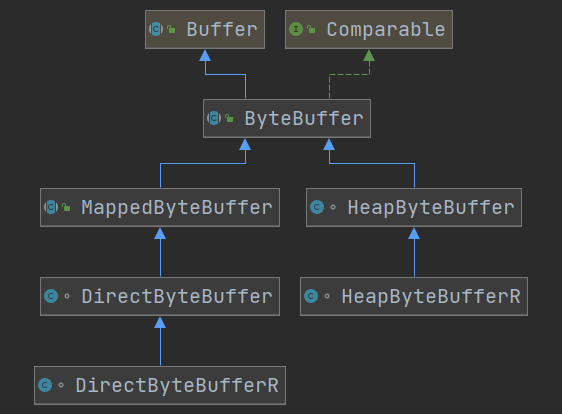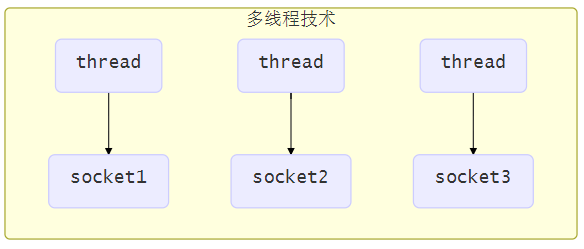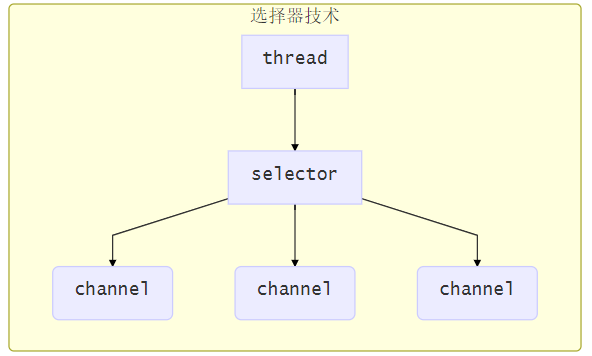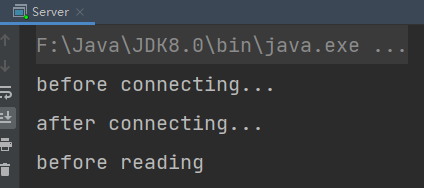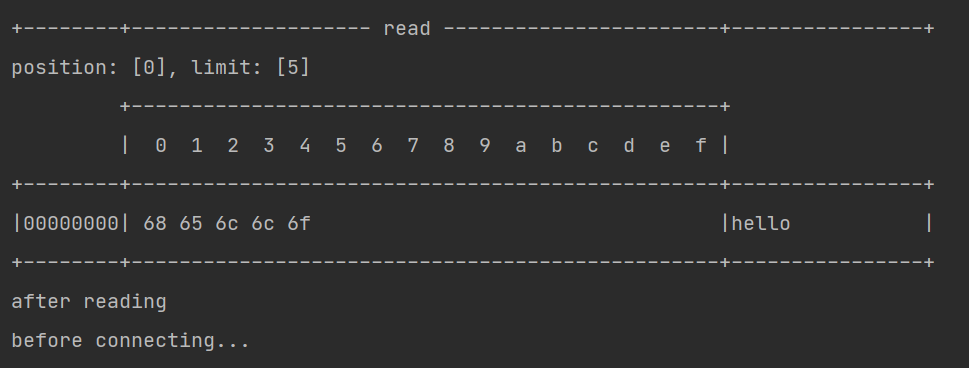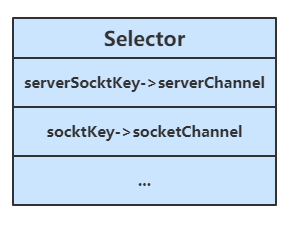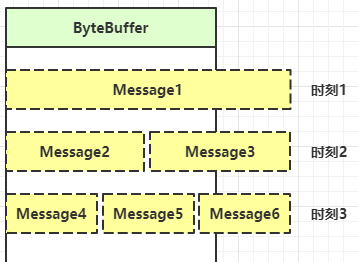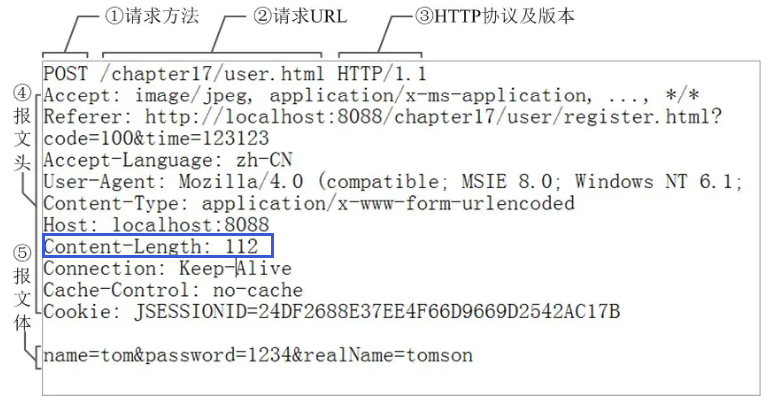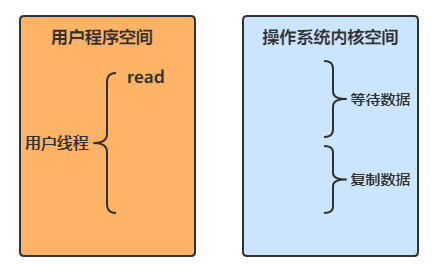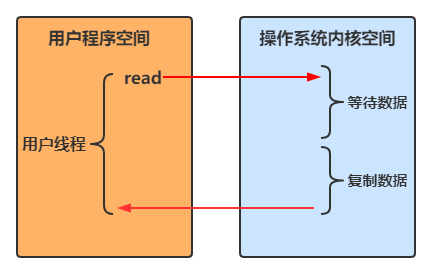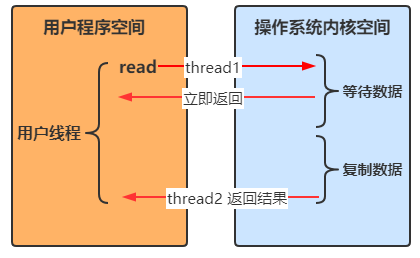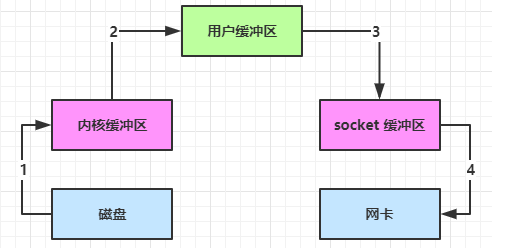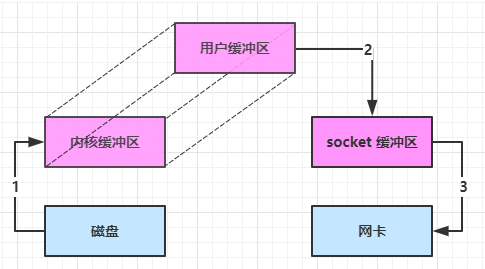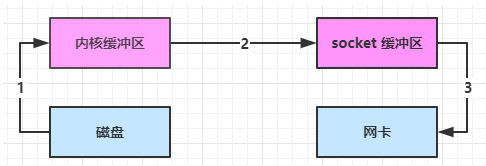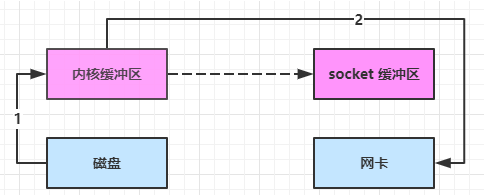Netty学习之NIO基础
本博客是根据黑马程序员Netty实战学习时所做的笔记
可先参考博客Java NIO
一、三大组件简介
Channel与Buffer
Java NIO系统的核心在于:通道(Channel)和缓冲区(Buffer)。通道表示打开到 IO 设备(例如:文件、套接字)的连接。若需要使用 NIO 系统,需要获取用于连接 IO 设备的通道以及用于容纳数据的缓冲区。然后操作缓冲区,对数据进行处理
简而言之,通道负责传输,缓冲区负责存储
常见的Channel有以下四种,其中FileChannel主要用于文件传输,其余三种用于网络通信
- FileChannel
- DatagramChannel
- SocketChannel
- ServerSocketChannel
Buffer有以下几种,其中使用较多的是ByteBuffer
- ByteBuffer
- MappedByteBuffer
- DirectByteBuffer
- HeapByteBuffer
- ShortBuffer
- IntBuffer
- LongBuffer
- FloatBuffer
- DoubleBuffer
- CharBuffer
1、Selector
在使用Selector之前,处理socket连接还有以下两种方法
使用多线程技术
为每个连接分别开辟一个线程,分别去处理对应的socke连接
这种方法存在以下几个问题
- 内存占用高
- 每个线程都需要占用一定的内存,当连接较多时,会开辟大量线程,导致占用大量内存
- 线程上下文切换成本高
- 只适合连接数少的场景
- 连接数过多,会导致创建很多线程,从而出现问题
使用线程池技术
使用线程池,让线程池中的线程去处理连接
这种方法存在以下几个问题
- 阻塞模式下,线程仅能处理一个连接
- 线程池中的线程获取任务(task)后,只有当其执行完任务之后(断开连接后),才会去获取并执行下一个任务
- 若socke连接一直未断开,则其对应的线程无法处理其他socke连接
- 仅适合短连接场景
- 短连接即建立连接发送请求并响应后就立即断开,使得线程池中的线程可以快速处理其他连接
使用选择器
selector 的作用就是配合一个线程来管理多个 channel(fileChannel因为是阻塞式的,所以无法使用selector),获取这些 channel 上发生的事件,这些 channel 工作在非阻塞模式下,当一个channel中没有执行任务时,可以去执行其他channel中的任务。适合连接数多,但流量较少的场景
若事件未就绪,调用 selector 的 select() 方法会阻塞线程,直到 channel 发生了就绪事件。这些事件就绪后,select 方法就会返回这些事件交给 thread 来处理
2、ByteBuffer
使用案例
使用方式
- 向 buffer 写入数据,例如调用 channel.read(buffer)
- 调用 flip() 切换至读模式
- flip会使得buffer中的limit变为position,position变为0
- 从 buffer 读取数据,例如调用 buffer.get()
- 调用 clear() 或者compact()切换至写模式
- 调用clear()方法时position=0,limit变为capacity
- 调用compact()方法时,会将缓冲区中的未读数据压缩到缓冲区前面
- 重复以上步骤
使用ByteBuffer读取文件中的内容
public class TestByteBuffer {
public static void main(String[] args) {
// 获得FileChannel
try (FileChannel channel = new FileInputStream("stu.txt").getChannel()) {
// 获得缓冲区
ByteBuffer buffer = ByteBuffer.allocate(10);
int hasNext = 0;
StringBuilder builder = new StringBuilder();
while((hasNext = channel.read(buffer)) > 0) {
// 切换模式 limit=position, position=0
buffer.flip();
// 当buffer中还有数据时,获取其中的数据
while(buffer.hasRemaining()) {
builder.append((char)buffer.get());
}
// 切换模式 position=0, limit=capacity
buffer.clear();
}
System.out.println(builder.toString());
} catch (IOException e) {
}
}
}打印结果
0123456789abcdef核心属性
字节缓冲区的父类Buffer中有几个核心属性,如下
// Invariants: mark <= position <= limit <= capacity
private int mark = -1;
private int position = 0;
private int limit;
private int capacity;- capacity:缓冲区的容量。通过构造函数赋予,一旦设置,无法更改
- limit:缓冲区的界限。位于limit 后的数据不可读写。缓冲区的限制不能为负,并且不能大于其容量
- position:下一个读写位置的索引(类似PC)。缓冲区的位置不能为负,并且不能大于limit
- mark:记录当前position的值。position被改变后,可以通过调用reset() 方法恢复到mark的位置。
以上四个属性必须满足以下要求
mark <= position <= limit <= capacity
核心方法
put()方法
- put()方法可以将一个数据放入到缓冲区中。
- 进行该操作后,postition的值会+1,指向下一个可以放入的位置。capacity = limit ,为缓冲区容量的值。
flip()方法
- flip()方法会切换对缓冲区的操作模式,由写->读 / 读->写
- 进行该操作后
- 如果是写模式->读模式,position = 0 , limit 指向最后一个元素的下一个位置,capacity不变
- 如果是读->写,则恢复为put()方法中的值
get()方法
- get()方法会读取缓冲区中的一个值
- 进行该操作后,position会+1,如果超过了limit则会抛出异常
- 注意:get(i)方法不会改变position的值
rewind()方法
- 该方法只能在读模式下使用
- rewind()方法后,会恢复position、limit和capacity的值,变为进行get()前的值
clean()方法
- clean()方法会将缓冲区中的各个属性恢复为最初的状态,position = 0, capacity = limit
- 此时缓冲区的数据依然存在,处于“被遗忘”状态,下次进行写操作时会覆盖这些数据
mark()和reset()方法
- mark()方法会将postion的值保存到mark属性中
- reset()方法会将position的值改为mark中保存的值
compact()方法
此方法为ByteBuffer的方法,而不是Buffer的方法
- compact会把未读完的数据向前压缩,然后切换到写模式
- 数据前移后,原位置的值并未清零,写时会覆盖之前的值
clear() VS compact()
clear只是对position、limit、mark进行重置,而compact在对position进行设置,以及limit、mark进行重置的同时,还涉及到数据在内存中拷贝(会调用arraycopy)。所以compact比clear更耗性能。但compact能保存你未读取的数据,将新数据追加到为读取的数据之后;而clear则不行,若你调用了clear,则未读取的数据就无法再读取到了
所以需要根据情况来判断使用哪种方法进行模式切换
方法调用及演示
ByteBuffer调试工具类
需要先导入netty依赖
<dependency>
<groupId>io.netty</groupId>
<artifactId>netty-all</artifactId>
<version>4.1.51.Final</version>
</dependency>import java.nio.ByteBuffer;
import io.netty.util.internal.MathUtil;
import io.netty.util.internal.StringUtil;
import io.netty.util.internal.MathUtil.*;
/**
* @author Panwen Chen
* @date 2021/4/12 15:59
*/
public class ByteBufferUtil {
private static final char[] BYTE2CHAR = new char[256];
private static final char[] HEXDUMP_TABLE = new char[256 * 4];
private static final String[] HEXPADDING = new String[16];
private static final String[] HEXDUMP_ROWPREFIXES = new String[65536 >>> 4];
private static final String[] BYTE2HEX = new String[256];
private static final String[] BYTEPADDING = new String[16];
static {
final char[] DIGITS = "0123456789abcdef".toCharArray();
for (int i = 0; i < 256; i++) {
HEXDUMP_TABLE[i << 1] = DIGITS[i >>> 4 & 0x0F];
HEXDUMP_TABLE[(i << 1) + 1] = DIGITS[i & 0x0F];
}
int i;
// Generate the lookup table for hex dump paddings
for (i = 0; i < HEXPADDING.length; i++) {
int padding = HEXPADDING.length - i;
StringBuilder buf = new StringBuilder(padding * 3);
for (int j = 0; j < padding; j++) {
buf.append(" ");
}
HEXPADDING[i] = buf.toString();
}
// Generate the lookup table for the start-offset header in each row (up to 64KiB).
for (i = 0; i < HEXDUMP_ROWPREFIXES.length; i++) {
StringBuilder buf = new StringBuilder(12);
buf.append(StringUtil.NEWLINE);
buf.append(Long.toHexString(i << 4 & 0xFFFFFFFFL | 0x100000000L));
buf.setCharAt(buf.length() - 9, '|');
buf.append('|');
HEXDUMP_ROWPREFIXES[i] = buf.toString();
}
// Generate the lookup table for byte-to-hex-dump conversion
for (i = 0; i < BYTE2HEX.length; i++) {
BYTE2HEX[i] = ' ' + StringUtil.byteToHexStringPadded(i);
}
// Generate the lookup table for byte dump paddings
for (i = 0; i < BYTEPADDING.length; i++) {
int padding = BYTEPADDING.length - i;
StringBuilder buf = new StringBuilder(padding);
for (int j = 0; j < padding; j++) {
buf.append(' ');
}
BYTEPADDING[i] = buf.toString();
}
// Generate the lookup table for byte-to-char conversion
for (i = 0; i < BYTE2CHAR.length; i++) {
if (i <= 0x1f || i >= 0x7f) {
BYTE2CHAR[i] = '.';
} else {
BYTE2CHAR[i] = (char) i;
}
}
}
/**
* 打印所有内容
* @param buffer
*/
public static void debugAll(ByteBuffer buffer) {
int oldlimit = buffer.limit();
buffer.limit(buffer.capacity());
StringBuilder origin = new StringBuilder(256);
appendPrettyHexDump(origin, buffer, 0, buffer.capacity());
System.out.println("+--------+-------------------- all ------------------------+----------------+");
System.out.printf("position: [%d], limit: [%d]\n", buffer.position(), oldlimit);
System.out.println(origin);
buffer.limit(oldlimit);
}
/**
* 打印可读取内容
* @param buffer
*/
public static void debugRead(ByteBuffer buffer) {
StringBuilder builder = new StringBuilder(256);
appendPrettyHexDump(builder, buffer, buffer.position(), buffer.limit() - buffer.position());
System.out.println("+--------+-------------------- read -----------------------+----------------+");
System.out.printf("position: [%d], limit: [%d]\n", buffer.position(), buffer.limit());
System.out.println(builder);
}
private static void appendPrettyHexDump(StringBuilder dump, ByteBuffer buf, int offset, int length) {
if (MathUtil.isOutOfBounds(offset, length, buf.capacity())) {
throw new IndexOutOfBoundsException(
"expected: " + "0 <= offset(" + offset + ") <= offset + length(" + length
+ ") <= " + "buf.capacity(" + buf.capacity() + ')');
}
if (length == 0) {
return;
}
dump.append(
" +-------------------------------------------------+" +
StringUtil.NEWLINE + " | 0 1 2 3 4 5 6 7 8 9 a b c d e f |" +
StringUtil.NEWLINE + "+--------+-------------------------------------------------+----------------+");
final int startIndex = offset;
final int fullRows = length >>> 4;
final int remainder = length & 0xF;
// Dump the rows which have 16 bytes.
for (int row = 0; row < fullRows; row++) {
int rowStartIndex = (row << 4) + startIndex;
// Per-row prefix.
appendHexDumpRowPrefix(dump, row, rowStartIndex);
// Hex dump
int rowEndIndex = rowStartIndex + 16;
for (int j = rowStartIndex; j < rowEndIndex; j++) {
dump.append(BYTE2HEX[getUnsignedByte(buf, j)]);
}
dump.append(" |");
// ASCII dump
for (int j = rowStartIndex; j < rowEndIndex; j++) {
dump.append(BYTE2CHAR[getUnsignedByte(buf, j)]);
}
dump.append('|');
}
// Dump the last row which has less than 16 bytes.
if (remainder != 0) {
int rowStartIndex = (fullRows << 4) + startIndex;
appendHexDumpRowPrefix(dump, fullRows, rowStartIndex);
// Hex dump
int rowEndIndex = rowStartIndex + remainder;
for (int j = rowStartIndex; j < rowEndIndex; j++) {
dump.append(BYTE2HEX[getUnsignedByte(buf, j)]);
}
dump.append(HEXPADDING[remainder]);
dump.append(" |");
// Ascii dump
for (int j = rowStartIndex; j < rowEndIndex; j++) {
dump.append(BYTE2CHAR[getUnsignedByte(buf, j)]);
}
dump.append(BYTEPADDING[remainder]);
dump.append('|');
}
dump.append(StringUtil.NEWLINE +
"+--------+-------------------------------------------------+----------------+");
}
private static void appendHexDumpRowPrefix(StringBuilder dump, int row, int rowStartIndex) {
if (row < HEXDUMP_ROWPREFIXES.length) {
dump.append(HEXDUMP_ROWPREFIXES[row]);
} else {
dump.append(StringUtil.NEWLINE);
dump.append(Long.toHexString(rowStartIndex & 0xFFFFFFFFL | 0x100000000L));
dump.setCharAt(dump.length() - 9, '|');
dump.append('|');
}
}
public static short getUnsignedByte(ByteBuffer buffer, int index) {
return (short) (buffer.get(index) & 0xFF);
}
}调用ByteBuffer的方法
public class TestByteBuffer {
public static void main(String[] args) {
ByteBuffer buffer = ByteBuffer.allocate(10);
// 向buffer中写入1个字节的数据
buffer.put((byte)97);
// 使用工具类,查看buffer状态
ByteBufferUtil.debugAll(buffer);
// 向buffer中写入4个字节的数据
buffer.put(new byte[]{98, 99, 100, 101});
ByteBufferUtil.debugAll(buffer);
// 获取数据
buffer.flip();
ByteBufferUtil.debugAll(buffer);
System.out.println(buffer.get());
System.out.println(buffer.get());
ByteBufferUtil.debugAll(buffer);
// 使用compact切换模式
buffer.compact();
ByteBufferUtil.debugAll(buffer);
// 再次写入
buffer.put((byte)102);
buffer.put((byte)103);
ByteBufferUtil.debugAll(buffer);
}
}运行结果
// 向缓冲区写入了一个字节的数据,此时postition为1
+--------+-------------------- all ------------------------+----------------+
position: [1], limit: [10]
+-------------------------------------------------+
| 0 1 2 3 4 5 6 7 8 9 a b c d e f |
+--------+-------------------------------------------------+----------------+
|00000000| 61 00 00 00 00 00 00 00 00 00 |a......... |
+--------+-------------------------------------------------+----------------+
// 向缓冲区写入四个字节的数据,此时position为5
+--------+-------------------- all ------------------------+----------------+
position: [5], limit: [10]
+-------------------------------------------------+
| 0 1 2 3 4 5 6 7 8 9 a b c d e f |
+--------+-------------------------------------------------+----------------+
|00000000| 61 62 63 64 65 00 00 00 00 00 |abcde..... |
+--------+-------------------------------------------------+----------------+
// 调用flip切换模式,此时position为0,表示从第0个数据开始读取
+--------+-------------------- all ------------------------+----------------+
position: [0], limit: [5]
+-------------------------------------------------+
| 0 1 2 3 4 5 6 7 8 9 a b c d e f |
+--------+-------------------------------------------------+----------------+
|00000000| 61 62 63 64 65 00 00 00 00 00 |abcde..... |
+--------+-------------------------------------------------+----------------+
// 读取两个字节的数据
97
98
// position变为2
+--------+-------------------- all ------------------------+----------------+
position: [2], limit: [5]
+-------------------------------------------------+
| 0 1 2 3 4 5 6 7 8 9 a b c d e f |
+--------+-------------------------------------------------+----------------+
|00000000| 61 62 63 64 65 00 00 00 00 00 |abcde..... |
+--------+-------------------------------------------------+----------------+
// 调用compact切换模式,此时position及其后面的数据被压缩到ByteBuffer前面去了
// 此时position为3,会覆盖之前的数据
+--------+-------------------- all ------------------------+----------------+
position: [3], limit: [10]
+-------------------------------------------------+
| 0 1 2 3 4 5 6 7 8 9 a b c d e f |
+--------+-------------------------------------------------+----------------+
|00000000| 63 64 65 64 65 00 00 00 00 00 |cdede..... |
+--------+-------------------------------------------------+----------------+
// 再次写入两个字节的数据,之前的 0x64 0x65 被覆盖
+--------+-------------------- all ------------------------+----------------+
position: [5], limit: [10]
+-------------------------------------------------+
| 0 1 2 3 4 5 6 7 8 9 a b c d e f |
+--------+-------------------------------------------------+----------------+
|00000000| 63 64 65 66 67 00 00 00 00 00 |cdefg..... |
+--------+-------------------------------------------------+----------------+字符串与ByteBuffer的相互转换
方法一
编码:字符串调用getByte方法获得byte数组,将byte数组放入ByteBuffer中
解码:先调用ByteBuffer的flip方法,然后通过StandardCharsets的decoder方法解码
public class Translate {
public static void main(String[] args) {
// 准备两个字符串
String str1 = "hello";
String str2 = "";
ByteBuffer buffer1 = ByteBuffer.allocate(16);
// 通过字符串的getByte方法获得字节数组,放入缓冲区中
buffer1.put(str1.getBytes());
ByteBufferUtil.debugAll(buffer1);
// 将缓冲区中的数据转化为字符串
// 切换模式
buffer1.flip();
// 通过StandardCharsets解码,获得CharBuffer,再通过toString获得字符串
str2 = StandardCharsets.UTF_8.decode(buffer1).toString();
System.out.println(str2);
ByteBufferUtil.debugAll(buffer1);
}
}运行结果
+--------+-------------------- all ------------------------+----------------+
position: [5], limit: [16]
+-------------------------------------------------+
| 0 1 2 3 4 5 6 7 8 9 a b c d e f |
+--------+-------------------------------------------------+----------------+
|00000000| 68 65 6c 6c 6f 00 00 00 00 00 00 00 00 00 00 00 |hello...........|
+--------+-------------------------------------------------+----------------+
hello
+--------+-------------------- all ------------------------+----------------+
position: [5], limit: [5]
+-------------------------------------------------+
| 0 1 2 3 4 5 6 7 8 9 a b c d e f |
+--------+-------------------------------------------------+----------------+
|00000000| 68 65 6c 6c 6f 00 00 00 00 00 00 00 00 00 00 00 |hello...........|
+--------+-------------------------------------------------+----------------+方法二
编码:通过StandardCharsets的encode方法获得ByteBuffer,此时获得的ByteBuffer为读模式,无需通过flip切换模式
解码:通过StandardCharsets的decoder方法解码
public class Translate {
public static void main(String[] args) {
// 准备两个字符串
String str1 = "hello";
String str2 = "";
// 通过StandardCharsets的encode方法获得ByteBuffer
// 此时获得的ByteBuffer为读模式,无需通过flip切换模式
ByteBuffer buffer1 = StandardCharsets.UTF_8.encode(str1);
ByteBufferUtil.debugAll(buffer1);
// 将缓冲区中的数据转化为字符串
// 通过StandardCharsets解码,获得CharBuffer,再通过toString获得字符串
str2 = StandardCharsets.UTF_8.decode(buffer1).toString();
System.out.println(str2);
ByteBufferUtil.debugAll(buffer1);
}
}运行结果
+--------+-------------------- all ------------------------+----------------+
position: [0], limit: [5]
+-------------------------------------------------+
| 0 1 2 3 4 5 6 7 8 9 a b c d e f |
+--------+-------------------------------------------------+----------------+
|00000000| 68 65 6c 6c 6f |hello |
+--------+-------------------------------------------------+----------------+
hello
+--------+-------------------- all ------------------------+----------------+
position: [5], limit: [5]
+-------------------------------------------------+
| 0 1 2 3 4 5 6 7 8 9 a b c d e f |
+--------+-------------------------------------------------+----------------+
|00000000| 68 65 6c 6c 6f |hello |
+--------+-------------------------------------------------+----------------+方法三
编码:字符串调用getByte()方法获得字节数组,将字节数组传给ByteBuffer的wrap()方法,通过该方法获得ByteBuffer。同样无需调用flip方法切换为读模式
解码:通过StandardCharsets的decoder方法解码
public class Translate {
public static void main(String[] args) {
// 准备两个字符串
String str1 = "hello";
String str2 = "";
// 通过StandardCharsets的encode方法获得ByteBuffer
// 此时获得的ByteBuffer为读模式,无需通过flip切换模式
ByteBuffer buffer1 = ByteBuffer.wrap(str1.getBytes());
ByteBufferUtil.debugAll(buffer1);
// 将缓冲区中的数据转化为字符串
// 通过StandardCharsets解码,获得CharBuffer,再通过toString获得字符串
str2 = StandardCharsets.UTF_8.decode(buffer1).toString();
System.out.println(str2);
ByteBufferUtil.debugAll(buffer1);
}
}运行结果
+--------+-------------------- all ------------------------+----------------+
position: [0], limit: [5]
+-------------------------------------------------+
| 0 1 2 3 4 5 6 7 8 9 a b c d e f |
+--------+-------------------------------------------------+----------------+
|00000000| 68 65 6c 6c 6f |hello |
+--------+-------------------------------------------------+----------------+
hello
+--------+-------------------- all ------------------------+----------------+
position: [5], limit: [5]
+-------------------------------------------------+
| 0 1 2 3 4 5 6 7 8 9 a b c d e f |
+--------+-------------------------------------------------+----------------+
|00000000| 68 65 6c 6c 6f |hello |
+--------+-------------------------------------------------+----------------+粘包与半包
现象
网络上有多条数据发送给服务端,数据之间使用 \n 进行分隔
但由于某种原因这些数据在接收时,被进行了重新组合,例如原始数据有3条为
- Hello,world\n
- I’m Nyima\n
- How are you?\n
变成了下面的两个 byteBuffer (粘包,半包)
- Hello,world\nI’m Nyima\nHo
- w are you?\n
出现原因
粘包
发送方在发送数据时,并不是一条一条地发送数据,而是将数据整合在一起,当数据达到一定的数量后再一起发送。这就会导致多条信息被放在一个缓冲区中被一起发送出去
半包
接收方的缓冲区的大小是有限的,当接收方的缓冲区满了以后,就需要将信息截断,等缓冲区空了以后再继续放入数据。这就会发生一段完整的数据最后被截断的现象
解决办法
- 通过get(index)方法遍历ByteBuffer,遇到分隔符时进行处理。注意:get(index)不会改变position的值
- 记录该段数据长度,以便于申请对应大小的缓冲区
- 将缓冲区的数据通过get()方法写入到target中
- 调用compact方法切换模式,因为缓冲区中可能还有未读的数据
public class ByteBufferDemo {
public static void main(String[] args) {
ByteBuffer buffer = ByteBuffer.allocate(32);
// 模拟粘包+半包
buffer.put("Hello,world\nI'm Nyima\nHo".getBytes());
// 调用split函数处理
split(buffer);
buffer.put("w are you?\n".getBytes());
split(buffer);
}
private static void split(ByteBuffer buffer) {
// 切换为读模式
buffer.flip();
for(int i = 0; i < buffer.limit(); i++) {
// 遍历寻找分隔符
// get(i)不会移动position
if (buffer.get(i) == '\n') {
// 缓冲区长度
int length = i+1-buffer.position();
ByteBuffer target = ByteBuffer.allocate(length);
// 将前面的内容写入target缓冲区
for(int j = 0; j < length; j++) {
// 将buffer中的数据写入target中
target.put(buffer.get());
}
// 打印查看结果
ByteBufferUtil.debugAll(target);
}
}
// 切换为写模式,但是缓冲区可能未读完,这里需要使用compact
buffer.compact();
}
}运行结果
+--------+-------------------- all ------------------------+----------------+
position: [12], limit: [12]
+-------------------------------------------------+
| 0 1 2 3 4 5 6 7 8 9 a b c d e f |
+--------+-------------------------------------------------+----------------+
|00000000| 48 65 6c 6c 6f 2c 77 6f 72 6c 64 0a |Hello,world. |
+--------+-------------------------------------------------+----------------+
+--------+-------------------- all ------------------------+----------------+
position: [10], limit: [10]
+-------------------------------------------------+
| 0 1 2 3 4 5 6 7 8 9 a b c d e f |
+--------+-------------------------------------------------+----------------+
|00000000| 49 27 6d 20 4e 79 69 6d 61 0a |I'm Nyima. |
+--------+-------------------------------------------------+----------------+
+--------+-------------------- all ------------------------+----------------+
position: [13], limit: [13]
+-------------------------------------------------+
| 0 1 2 3 4 5 6 7 8 9 a b c d e f |
+--------+-------------------------------------------------+----------------+
|00000000| 48 6f 77 20 61 72 65 20 79 6f 75 3f 0a |How are you?. |
+--------+-------------------------------------------------+----------------+二、文件编程
1、FileChannel
工作模式
FileChannel只能在阻塞模式下工作,所以无法搭配Selector
获取
不能直接打开 FileChannel,必须通过 FileInputStream、FileOutputStream 或者 RandomAccessFile 来获取 FileChannel,它们都有 getChannel 方法
- 通过 FileInputStream 获取的 channel 只能读
- 通过 FileOutputStream 获取的 channel 只能写
- 通过 RandomAccessFile 是否能读写根据构造 RandomAccessFile 时的读写模式决定
读取
通过 FileInputStream 获取channel,通过read方法将数据写入到ByteBuffer中
read方法的返回值表示读到了多少字节,若读到了文件末尾则返回-1
int readBytes = channel.read(buffer);可根据返回值判断是否读取完毕
while(channel.read(buffer) > 0) {
// 进行对应操作
...
}写入
因为channel也是有大小的,所以 write 方法并不能保证一次将 buffer 中的内容全部写入 channel。必须需要按照以下规则进行写入
// 通过hasRemaining()方法查看缓冲区中是否还有数据未写入到通道中
while(buffer.hasRemaining()) {
channel.write(buffer);
}关闭
通道需要close,一般情况通过try-with-resource进行关闭,最好使用以下方法获取strea以及channel,避免某些原因使得资源未被关闭
public class TestChannel {
public static void main(String[] args) throws IOException {
try (FileInputStream fis = new FileInputStream("stu.txt");
FileOutputStream fos = new FileOutputStream("student.txt");
FileChannel inputChannel = fis.getChannel();
FileChannel outputChannel = fos.getChannel()) {
// 执行对应操作
...
}
}
}位置
position
channel也拥有一个保存读取数据位置的属性,即position
long pos = channel.position();可以通过position(int pos)设置channel中position的值
long newPos = ...;
channel.position(newPos);设置当前位置时,如果设置为文件的末尾
- 这时读取会返回 -1
- 这时写入,会追加内容,但要注意如果 position 超过了文件末尾,再写入时在新内容和原末尾之间会有空洞(00)
强制写入
操作系统出于性能的考虑,会将数据缓存,不是立刻写入磁盘,而是等到缓存满了以后将所有数据一次性的写入磁盘。可以调用 force(true) 方法将文件内容和元数据(文件的权限等信息)立刻写入磁盘
2、两个Channel传输数据
transferTo方法
使用transferTo方法可以快速、高效地将一个channel中的数据传输到另一个channel中,但一次只能传输2G的内容
transferTo底层使用了零拷贝技术
public class TestChannel {
public static void main(String[] args){
try (FileInputStream fis = new FileInputStream("stu.txt");
FileOutputStream fos = new FileOutputStream("student.txt");
FileChannel inputChannel = fis.getChannel();
FileChannel outputChannel = fos.getChannel()) {
// 参数:inputChannel的起始位置,传输数据的大小,目的channel
// 返回值为传输的数据的字节数
// transferTo一次只能传输2G的数据
inputChannel.transferTo(0, inputChannel.size(), outputChannel);
} catch (IOException e) {
e.printStackTrace();
}
}
}当传输的文件大于2G时,需要使用以下方法进行多次传输
public class TestChannel {
public static void main(String[] args){
try (FileInputStream fis = new FileInputStream("stu.txt");
FileOutputStream fos = new FileOutputStream("student.txt");
FileChannel inputChannel = fis.getChannel();
FileChannel outputChannel = fos.getChannel()) {
long size = inputChannel.size();
long capacity = inputChannel.size();
// 分多次传输
while (capacity > 0) {
// transferTo返回值为传输了的字节数
capacity -= inputChannel.transferTo(size-capacity, capacity, outputChannel);
}
} catch (IOException e) {
e.printStackTrace();
}
}
}3、Path与Paths
- Path 用来表示文件路径
- Paths 是工具类,用来获取 Path 实例
Path source = Paths.get("1.txt"); // 相对路径 不带盘符 使用 user.dir 环境变量来定位 1.txt
Path source = Paths.get("d:\\1.txt"); // 绝对路径 代表了 d:\1.txt 反斜杠需要转义
Path source = Paths.get("d:/1.txt"); // 绝对路径 同样代表了 d:\1.txt
Path projects = Paths.get("d:\\data", "projects"); // 代表了 d:\data\projects.代表了当前路径..代表了上一级路径
例如目录结构如下
d:
|- data
|- projects
|- a
|- b代码
Path path = Paths.get("d:\\data\\projects\\a\\..\\b");
System.out.println(path);
System.out.println(path.normalize()); // 正常化路径 会去除 . 以及 ..输出结果为
d:\data\projects\a\..\b
d:\data\projects\b4、Files
查找
检查文件是否存在
Path path = Paths.get("helloword/data.txt");
System.out.println(Files.exists(path));创建
创建一级目录
Path path = Paths.get("helloword/d1");
Files.createDirectory(path);- 如果目录已存在,会抛异常 FileAlreadyExistsException
- 不能一次创建多级目录,否则会抛异常 NoSuchFileException
创建多级目录用
Path path = Paths.get("helloword/d1/d2");
Files.createDirectories(path);拷贝及移动
拷贝文件
Path source = Paths.get("helloword/data.txt");
Path target = Paths.get("helloword/target.txt");
Files.copy(source, target);- 如果文件已存在,会抛异常 FileAlreadyExistsException
如果希望用 source 覆盖掉 target,需要用 StandardCopyOption 来控制
Files.copy(source, target, StandardCopyOption.REPLACE_EXISTING);移动文件
Path source = Paths.get("helloword/data.txt");
Path target = Paths.get("helloword/data.txt");
Files.move(source, target, StandardCopyOption.ATOMIC_MOVE);- StandardCopyOption.ATOMIC_MOVE 保证文件移动的原子性
删除
删除文件
Path target = Paths.get("helloword/target.txt");
Files.delete(target);- 如果文件不存在,会抛异常 NoSuchFileException
删除目录
Path target = Paths.get("helloword/d1");
Files.delete(target);- 如果目录还有内容,会抛异常 DirectoryNotEmptyException
遍历
可以使用Files工具类中的walkFileTree(Path, FileVisitor)方法,其中需要传入两个参数
- Path:文件起始路径
- FileVisitor:文件访问器,使用访问者模式
- 接口的实现类SimpleFileVisitor有四个方法
- preVisitDirectory:访问目录前的操作
- visitFile:访问文件的操作
- visitFileFailed:访问文件失败时的操作
- postVisitDirectory:访问目录后的操作
- 接口的实现类SimpleFileVisitor有四个方法
public class TestWalkFileTree {
public static void main(String[] args) throws IOException {
Path path = Paths.get("F:\\JDK 8");
// 文件目录数目
AtomicInteger dirCount = new AtomicInteger();
// 文件数目
AtomicInteger fileCount = new AtomicInteger();
Files.walkFileTree(path, new SimpleFileVisitor<Path>(){
@Override
public FileVisitResult preVisitDirectory(Path dir, BasicFileAttributes attrs) throws IOException {
System.out.println("===>"+dir);
// 增加文件目录数
dirCount.incrementAndGet();
return super.preVisitDirectory(dir, attrs);
}
@Override
public FileVisitResult visitFile(Path file, BasicFileAttributes attrs) throws IOException {
System.out.println(file);
// 增加文件数
fileCount.incrementAndGet();
return super.visitFile(file, attrs);
}
});
// 打印数目
System.out.println("文件目录数:"+dirCount.get());
System.out.println("文件数:"+fileCount.get());
}
}运行结果如下
...
===>F:\JDK 8\lib\security\policy\unlimited
F:\JDK 8\lib\security\policy\unlimited\local_policy.jar
F:\JDK 8\lib\security\policy\unlimited\US_export_policy.jar
F:\JDK 8\lib\security\trusted.libraries
F:\JDK 8\lib\sound.properties
F:\JDK 8\lib\tzdb.dat
F:\JDK 8\lib\tzmappings
F:\JDK 8\LICENSE
F:\JDK 8\README.txt
F:\JDK 8\release
F:\JDK 8\THIRDPARTYLICENSEREADME-JAVAFX.txt
F:\JDK 8\THIRDPARTYLICENSEREADME.txt
F:\JDK 8\Welcome.html
文件目录数:23
文件数:279三、网络编程
1、阻塞
- 阻塞模式下,相关方法都会导致线程暂停
- ServerSocketChannel.accept 会在没有连接建立时让线程暂停
- SocketChannel.read 会在通道中没有数据可读时让线程暂停
- 阻塞的表现其实就是线程暂停了,暂停期间不会占用 cpu,但线程相当于闲置
- 单线程下,阻塞方法之间相互影响,几乎不能正常工作,需要多线程支持
- 但多线程下,有新的问题,体现在以下方面
- 32 位 jvm 一个线程 320k,64 位 jvm 一个线程 1024k,如果连接数过多,必然导致 OOM,并且线程太多,反而会因为频繁上下文切换导致性能降低
- 可以采用线程池技术来减少线程数和线程上下文切换,但治标不治本,如果有很多连接建立,但长时间 inactive,会阻塞线程池中所有线程,因此不适合长连接,只适合短连接
服务端代码
public class Server {
public static void main(String[] args) {
// 创建缓冲区
ByteBuffer buffer = ByteBuffer.allocate(16);
// 获得服务器通道
try(ServerSocketChannel server = ServerSocketChannel.open()) {
// 为服务器通道绑定端口
server.bind(new InetSocketAddress(8080));
// 用户存放连接的集合
ArrayList<SocketChannel> channels = new ArrayList<>();
// 循环接收连接
while (true) {
System.out.println("before connecting...");
// 没有连接时,会阻塞线程
SocketChannel socketChannel = server.accept();
System.out.println("after connecting...");
channels.add(socketChannel);
// 循环遍历集合中的连接
for(SocketChannel channel : channels) {
System.out.println("before reading");
// 处理通道中的数据
// 当通道中没有数据可读时,会阻塞线程
channel.read(buffer);
buffer.flip();
ByteBufferUtil.debugRead(buffer);
buffer.clear();
System.out.println("after reading");
}
}
} catch (IOException e) {
e.printStackTrace();
}
}
}客户端代码
public class Client {
public static void main(String[] args) {
try (SocketChannel socketChannel = SocketChannel.open()) {
// 建立连接
socketChannel.connect(new InetSocketAddress("localhost", 8080));
System.out.println("waiting...");
} catch (IOException e) {
e.printStackTrace();
}
}
}运行结果
- 客户端-服务器建立连接前:服务器端因accept阻塞
- 客户端-服务器建立连接后,客户端发送消息前:服务器端因通道为空被阻塞
- 客户端发送数据后,服务器处理通道中的数据。再次进入循环时,再次被accept阻塞
- 之前的客户端再次发送消息,服务器端因为被accept阻塞,无法处理之前客户端发送到通道中的信息
2、非阻塞
-
可以通过ServerSocketChannel的configureBlocking(false)方法将获得连接设置为非阻塞的。此时若没有连接,accept会返回null
-
可以通过SocketChannel的configureBlocking(false)方法将从通道中读取数据设置为非阻塞的。若此时通道中没有数据可读,read会返回-1
服务器代码如下
public class Server {
public static void main(String[] args) {
// 创建缓冲区
ByteBuffer buffer = ByteBuffer.allocate(16);
// 获得服务器通道
try(ServerSocketChannel server = ServerSocketChannel.open()) {
// 为服务器通道绑定端口
server.bind(new InetSocketAddress(8080));
// 用户存放连接的集合
ArrayList<SocketChannel> channels = new ArrayList<>();
// 循环接收连接
while (true) {
// 设置为非阻塞模式,没有连接时返回null,不会阻塞线程
server.configureBlocking(false);
SocketChannel socketChannel = server.accept();
// 通道不为空时才将连接放入到集合中
if (socketChannel != null) {
System.out.println("after connecting...");
channels.add(socketChannel);
}
// 循环遍历集合中的连接
for(SocketChannel channel : channels) {
// 处理通道中的数据
// 设置为非阻塞模式,若通道中没有数据,会返回0,不会阻塞线程
channel.configureBlocking(false);
int read = channel.read(buffer);
if(read > 0) {
buffer.flip();
ByteBufferUtil.debugRead(buffer);
buffer.clear();
System.out.println("after reading");
}
}
}
} catch (IOException e) {
e.printStackTrace();
}
}
}这样写存在一个问题,因为设置为了非阻塞,会一直执行while(true)中的代码,CPU一直处于忙碌状态,会使得性能变低,所以实际情况中不使用这种方法处理请求
3、Selector
多路复用
单线程可以配合 Selector 完成对多个 Channel 可读写事件的监控,这称之为多路复用
- 多路复用仅针对网络 IO,普通文件 IO 无法利用多路复用
- 如果不用 Selector 的非阻塞模式,线程大部分时间都在做无用功,而 Selector 能够保证
- 有可连接事件时才去连接
- 有可读事件才去读取
- 有可写事件才去写入
- 限于网络传输能力,Channel 未必时时可写,一旦 Channel 可写,会触发 Selector 的可写事件
4、使用及Accpet事件
要使用Selector实现多路复用,服务端代码如下改进
public class SelectServer {
public static void main(String[] args) {
ByteBuffer buffer = ByteBuffer.allocate(16);
// 获得服务器通道
try(ServerSocketChannel server = ServerSocketChannel.open()) {
server.bind(new InetSocketAddress(8080));
// 创建选择器
Selector selector = Selector.open();
// 通道必须设置为非阻塞模式
server.configureBlocking(false);
// 将通道注册到选择器中,并设置感兴趣的事件
server.register(selector, SelectionKey.OP_ACCEPT);
while (true) {
// 若没有事件就绪,线程会被阻塞,反之不会被阻塞。从而避免了CPU空转
// 返回值为就绪的事件个数
int ready = selector.select();
System.out.println("selector ready counts : " + ready);
// 获取所有事件
Set<SelectionKey> selectionKeys = selector.selectedKeys();
// 使用迭代器遍历事件
Iterator<SelectionKey> iterator = selectionKeys.iterator();
while (iterator.hasNext()) {
SelectionKey key = iterator.next();
// 判断key的类型
if(key.isAcceptable()) {
// 获得key对应的channel
ServerSocketChannel channel = (ServerSocketChannel) key.channel();
System.out.println("before accepting...");
// 获取连接并处理,而且是必须处理,否则需要取消
SocketChannel socketChannel = channel.accept();
System.out.println("after accepting...");
// 处理完毕后移除
iterator.remove();
}
}
}
} catch (IOException e) {
e.printStackTrace();
}
}
}步骤解析
- 获得选择器Selector
Selector selector = Selector.open();- 将通道设置为非阻塞模式,并注册到选择器中,并设置感兴趣的事件
- channel 必须工作在非阻塞模式
- FileChannel 没有非阻塞模式,因此不能配合 selector 一起使用
- 绑定的事件类型可以有
- connect - 客户端连接成功时触发
- accept - 服务器端成功接受连接时触发
- read - 数据可读入时触发,有因为接收能力弱,数据暂不能读入的情况
- write - 数据可写出时触发,有因为发送能力弱,数据暂不能写出的情况
// 通道必须设置为非阻塞模式
server.configureBlocking(false);
// 将通道注册到选择器中,并设置感兴趣的实践
server.register(selector, SelectionKey.OP_ACCEPT);-
通过Selector监听事件,并获得就绪的通道个数,若没有通道就绪,线程会被阻塞
-
阻塞直到绑定事件发生
int count = selector.select(); -
阻塞直到绑定事件发生,或是超时(时间单位为 ms)
int count = selector.select(long timeout); -
不会阻塞,也就是不管有没有事件,立刻返回,自己根据返回值检查是否有事件
int count = selector.selectNow();
-
-
获取就绪事件并得到对应的通道,然后进行处理
// 获取所有事件
Set<SelectionKey> selectionKeys = selector.selectedKeys();
// 使用迭代器遍历事件
Iterator<SelectionKey> iterator = selectionKeys.iterator();
while (iterator.hasNext()) {
SelectionKey key = iterator.next();
// 判断key的类型,此处为Accept类型
if(key.isAcceptable()) {
// 获得key对应的channel
ServerSocketChannel channel = (ServerSocketChannel) key.channel();
// 获取连接并处理,而且是必须处理,否则需要取消
SocketChannel socketChannel = channel.accept();
// 处理完毕后移除
iterator.remove();
}
}事件发生后能否不处理
事件发生后,要么处理,要么取消(cancel),不能什么都不做,否则下次该事件仍会触发,这是因为 nio 底层使用的是水平触发
5、Read事件
- 在Accept事件中,若有客户端与服务器端建立了连接,需要将其对应的SocketChannel设置为非阻塞,并注册到选择其中
- 添加Read事件,触发后进行读取操作
public class SelectServer {
public static void main(String[] args) {
ByteBuffer buffer = ByteBuffer.allocate(16);
// 获得服务器通道
try(ServerSocketChannel server = ServerSocketChannel.open()) {
server.bind(new InetSocketAddress(8080));
// 创建选择器
Selector selector = Selector.open();
// 通道必须设置为非阻塞模式
server.configureBlocking(false);
// 将通道注册到选择器中,并设置感兴趣的实践
server.register(selector, SelectionKey.OP_ACCEPT);
// 为serverKey设置感兴趣的事件
while (true) {
// 若没有事件就绪,线程会被阻塞,反之不会被阻塞。从而避免了CPU空转
// 返回值为就绪的事件个数
int ready = selector.select();
System.out.println("selector ready counts : " + ready);
// 获取所有事件
Set<SelectionKey> selectionKeys = selector.selectedKeys();
// 使用迭代器遍历事件
Iterator<SelectionKey> iterator = selectionKeys.iterator();
while (iterator.hasNext()) {
SelectionKey key = iterator.next();
// 判断key的类型
if(key.isAcceptable()) {
// 获得key对应的channel
ServerSocketChannel channel = (ServerSocketChannel) key.channel();
System.out.println("before accepting...");
// 获取连接
SocketChannel socketChannel = channel.accept();
System.out.println("after accepting...");
// 设置为非阻塞模式,同时将连接的通道也注册到选择其中
socketChannel.configureBlocking(false);
socketChannel.register(selector, SelectionKey.OP_READ);
// 处理完毕后移除
iterator.remove();
} else if (key.isReadable()) {
SocketChannel channel = (SocketChannel) key.channel();
System.out.println("before reading...");
channel.read(buffer);
System.out.println("after reading...");
buffer.flip();
ByteBufferUtil.debugRead(buffer);
buffer.clear();
// 处理完毕后移除
iterator.remove();
}
}
}
} catch (IOException e) {
e.printStackTrace();
}
}
}删除事件
当处理完一个事件后,一定要调用迭代器的remove方法移除对应事件,否则会出现错误。原因如下
以我们上面的 Read事件 的代码为例
-
当调用了 server.register(selector, SelectionKey.OP_ACCEPT)后,Selector中维护了一个集合,用于存放SelectionKey以及其对应的通道
// WindowsSelectorImpl 中的 SelectionKeyImpl数组 private SelectionKeyImpl[] channelArray = new SelectionKeyImpl[8];public class SelectionKeyImpl extends AbstractSelectionKey { // Key对应的通道 final SelChImpl channel; ... } -
当选择器中的通道对应的事件发生后,selecionKey会被放到另一个集合中,但是selecionKey不会自动移除,所以需要我们在处理完一个事件后,通过迭代器手动移除其中的selecionKey。否则会导致已被处理过的事件再次被处理,就会引发错误

断开处理
当客户端与服务器之间的连接断开时,会给服务器端发送一个读事件,对异常断开和正常断开需要加以不同的方式进行处理
-
正常断开
-
正常断开时,服务器端的channel.read(buffer)方法的返回值为-1,所以当结束到返回值为-1时,需要调用key的cancel方法取消此事件,并在取消后移除该事件
int read = channel.read(buffer); // 断开连接时,客户端会向服务器发送一个写事件,此时read的返回值为-1 if(read == -1) { // 取消该事件的处理 key.cancel(); channel.close(); } else { ... } // 取消或者处理,都需要移除key iterator.remove();
-
-
异常断开
- 异常断开时,会抛出IOException异常, 在try-catch的catch块中捕获异常并调用key的cancel方法即可
消息边界
不处理消息边界存在的问题
将缓冲区的大小设置为4个字节,发送2个汉字(你好),通过decode解码并打印时,会出现乱码
ByteBuffer buffer = ByteBuffer.allocate(4);
// 解码并打印
System.out.println(StandardCharsets.UTF_8.decode(buffer));你�
��这是因为UTF-8字符集下,1个汉字占用3个字节,此时缓冲区大小为4个字节,一次读时间无法处理完通道中的所有数据,所以一共会触发两次读事件。这就导致 你好 的 好 字被拆分为了前半部分和后半部分发送,解码时就会出现问题
处理消息边界
传输的文本可能有以下三种情况
- 文本大于缓冲区大小
- 此时需要将缓冲区进行扩容
- 发生半包现象
- 发生粘包现象
解决思路大致有以下三种
- 固定消息长度,数据包大小一样,服务器按预定长度读取,当发送的数据较少时,需要将数据进行填充,直到长度与消息规定长度一致。缺点是浪费带宽
- 另一种思路是按分隔符拆分,缺点是效率低,需要一个一个字符地去匹配分隔符
- TLV 格式,即 Type 类型、Length 长度、Value 数据(也就是在消息开头用一些空间存放后面数据的长度),如HTTP请求头中的Content-Type与Content-Length。类型和长度已知的情况下,就可以方便获取消息大小,分配合适的 buffer,缺点是 buffer 需要提前分配,如果内容过大,则影响 server 吞吐量
下文的消息边界处理方式为第二种:按分隔符拆分
附件与扩容
Channel的register方法还有第三个参数:附件,可以向其中放入一个Object类型的对象,该对象会与登记的Channel以及其对应的SelectionKey绑定,可以从SelectionKey获取到对应通道的附件
public final SelectionKey register(Selector sel, int ops, Object att)可通过SelectionKey的attachment()方法获得附件
ByteBuffer buffer = (ByteBuffer) key.attachment();我们需要在Accept事件发生后,将通道注册到Selector中时,对每个通道添加一个ByteBuffer附件,让每个通道发生读事件时都使用自己的通道,避免与其他通道发生冲突而导致问题
// 设置为非阻塞模式,同时将连接的通道也注册到选择其中,同时设置附件
socketChannel.configureBlocking(false);
ByteBuffer buffer = ByteBuffer.allocate(16);
// 添加通道对应的Buffer附件
socketChannel.register(selector, SelectionKey.OP_READ, buffer);当Channel中的数据大于缓冲区时,需要对缓冲区进行扩容操作。此代码中的扩容的判定方法:Channel调用compact方法后,的position与limit相等,说明缓冲区中的数据并未被读取(容量太小),此时创建新的缓冲区,其大小扩大为两倍。同时还要将旧缓冲区中的数据拷贝到新的缓冲区中,同时调用SelectionKey的attach方法将新的缓冲区作为新的附件放入SelectionKey中
// 如果缓冲区太小,就进行扩容
if (buffer.position() == buffer.limit()) {
ByteBuffer newBuffer = ByteBuffer.allocate(buffer.capacity()*2);
// 将旧buffer中的内容放入新的buffer中
ewBuffer.put(buffer);
// 将新buffer作为附件放到key中
key.attach(newBuffer);
}改造后的服务器代码如下
public class SelectServer {
public static void main(String[] args) {
// 获得服务器通道
try(ServerSocketChannel server = ServerSocketChannel.open()) {
server.bind(new InetSocketAddress(8080));
// 创建选择器
Selector selector = Selector.open();
// 通道必须设置为非阻塞模式
server.configureBlocking(false);
// 将通道注册到选择器中,并设置感兴趣的事件
server.register(selector, SelectionKey.OP_ACCEPT);
// 为serverKey设置感兴趣的事件
while (true) {
// 若没有事件就绪,线程会被阻塞,反之不会被阻塞。从而避免了CPU空转
// 返回值为就绪的事件个数
int ready = selector.select();
System.out.println("selector ready counts : " + ready);
// 获取所有事件
Set<SelectionKey> selectionKeys = selector.selectedKeys();
// 使用迭代器遍历事件
Iterator<SelectionKey> iterator = selectionKeys.iterator();
while (iterator.hasNext()) {
SelectionKey key = iterator.next();
// 判断key的类型
if(key.isAcceptable()) {
// 获得key对应的channel
ServerSocketChannel channel = (ServerSocketChannel) key.channel();
System.out.println("before accepting...");
// 获取连接
SocketChannel socketChannel = channel.accept();
System.out.println("after accepting...");
// 设置为非阻塞模式,同时将连接的通道也注册到选择其中,同时设置附件
socketChannel.configureBlocking(false);
ByteBuffer buffer = ByteBuffer.allocate(16);
socketChannel.register(selector, SelectionKey.OP_READ, buffer);
// 处理完毕后移除
iterator.remove();
} else if (key.isReadable()) {
SocketChannel channel = (SocketChannel) key.channel();
System.out.println("before reading...");
// 通过key获得附件(buffer)
ByteBuffer buffer = (ByteBuffer) key.attachment();
int read = channel.read(buffer);
if(read == -1) {
key.cancel();
channel.close();
} else {
// 通过分隔符来分隔buffer中的数据
split(buffer);
// 如果缓冲区太小,就进行扩容
if (buffer.position() == buffer.limit()) {
ByteBuffer newBuffer = ByteBuffer.allocate(buffer.capacity()*2);
// 将旧buffer中的内容放入新的buffer中
buffer.flip();
newBuffer.put(buffer);
// 将新buffer放到key中作为附件
key.attach(newBuffer);
}
}
System.out.println("after reading...");
// 处理完毕后移除
iterator.remove();
}
}
}
} catch (IOException e) {
e.printStackTrace();
}
}
private static void split(ByteBuffer buffer) {
buffer.flip();
for(int i = 0; i < buffer.limit(); i++) {
// 遍历寻找分隔符
// get(i)不会移动position
if (buffer.get(i) == '\n') {
// 缓冲区长度
int length = i+1-buffer.position();
ByteBuffer target = ByteBuffer.allocate(length);
// 将前面的内容写入target缓冲区
for(int j = 0; j < length; j++) {
// 将buffer中的数据写入target中
target.put(buffer.get());
}
// 打印结果
ByteBufferUtil.debugAll(target);
}
}
// 切换为写模式,但是缓冲区可能未读完,这里需要使用compact
buffer.compact();
}
}ByteBuffer的大小分配
- 每个 channel 都需要记录可能被切分的消息,因为 ByteBuffer 不能被多个 channel 共同使用,因此需要为每个 channel 维护一个独立的 ByteBuffer
- ByteBuffer 不能太大,比如一个 ByteBuffer 1Mb 的话,要支持百万连接就要 1Tb 内存,因此需要设计大小可变的 ByteBuffer
- 分配思路可以参考
- 一种思路是首先分配一个较小的 buffer,例如 4k,如果发现数据不够,再分配 8k 的 buffer,将 4k buffer 内容拷贝至 8k buffer,优点是消息连续容易处理,缺点是数据拷贝耗费性能
- 另一种思路是用多个数组组成 buffer,一个数组不够,把多出来的内容写入新的数组,与前面的区别是消息存储不连续解析复杂,优点是避免了拷贝引起的性能损耗
6、Write事件
服务器通过Buffer向通道中写入数据时,可能因为通道容量小于Buffer中的数据大小,导致无法一次性将Buffer中的数据全部写入到Channel中,这时便需要分多次写入,具体步骤如下
-
执行一次写操作,向将buffer中的内容写入到SocketChannel中,然后判断Buffer中是否还有数据
-
若Buffer中还有数据,则需要将SockerChannel注册到Seletor中,并关注写事件,同时将未写完的Buffer作为附件一起放入到SelectionKey中
int write = socket.write(buffer); // 通道中可能无法放入缓冲区中的所有数据 if (buffer.hasRemaining()) { // 注册到Selector中,关注可写事件,并将buffer添加到key的附件中 socket.configureBlocking(false); socket.register(selector, SelectionKey.OP_WRITE, buffer); } -
添加写事件的相关操作
key.isWritable(),对Buffer再次进行写操作- 每次写后需要判断Buffer中是否还有数据(是否写完)。若写完,需要移除SelecionKey中的Buffer附件,避免其占用过多内存,同时还需移除对写事件的关注
SocketChannel socket = (SocketChannel) key.channel(); // 获得buffer ByteBuffer buffer = (ByteBuffer) key.attachment(); // 执行写操作 int write = socket.write(buffer); System.out.println(write); // 如果已经完成了写操作,需要移除key中的附件,同时不再对写事件感兴趣 if (!buffer.hasRemaining()) { key.attach(null); key.interestOps(0); }
整体代码如下
public class WriteServer {
public static void main(String[] args) {
try(ServerSocketChannel server = ServerSocketChannel.open()) {
server.bind(new InetSocketAddress(8080));
server.configureBlocking(false);
Selector selector = Selector.open();
server.register(selector, SelectionKey.OP_ACCEPT);
while (true) {
selector.select();
Set<SelectionKey> selectionKeys = selector.selectedKeys();
Iterator<SelectionKey> iterator = selectionKeys.iterator();
while (iterator.hasNext()) {
SelectionKey key = iterator.next();
// 处理后就移除事件
iterator.remove();
if (key.isAcceptable()) {
// 获得客户端的通道
SocketChannel socket = server.accept();
// 写入数据
StringBuilder builder = new StringBuilder();
for(int i = 0; i < 500000000; i++) {
builder.append("a");
}
ByteBuffer buffer = StandardCharsets.UTF_8.encode(builder.toString());
// 先执行一次Buffer->Channel的写入,如果未写完,就添加一个可写事件
int write = socket.write(buffer);
System.out.println(write);
// 通道中可能无法放入缓冲区中的所有数据
if (buffer.hasRemaining()) {
// 注册到Selector中,关注可写事件,并将buffer添加到key的附件中
socket.configureBlocking(false);
socket.register(selector, SelectionKey.OP_WRITE, buffer);
}
} else if (key.isWritable()) {
SocketChannel socket = (SocketChannel) key.channel();
// 获得buffer
ByteBuffer buffer = (ByteBuffer) key.attachment();
// 执行写操作
int write = socket.write(buffer);
System.out.println(write);
// 如果已经完成了写操作,需要移除key中的附件,同时不再对写事件感兴趣
if (!buffer.hasRemaining()) {
key.attach(null);
key.interestOps(0);
}
}
}
}
} catch (IOException e) {
e.printStackTrace();
}
}
}7、优化
多线程优化
充分利用多核CPU,分两组选择器
- 单线程配一个选择器(Boss),专门处理 accept 事件
- 创建 cpu 核心数的线程(Worker),每个线程配一个选择器,轮流处理 read 事件
实现思路
-
创建一个负责处理Accept事件的Boss线程,与多个负责处理Read事件的Worker线程
-
Boss线程执行的操作
-
接受并处理Accepet事件,当Accept事件发生后,调用Worker的register(SocketChannel socket)方法,让Worker去处理Read事件,其中需要根据标识robin去判断将任务分配给哪个Worker
// 创建固定数量的Worker Worker[] workers = new Worker[4]; // 用于负载均衡的原子整数 AtomicInteger robin = new AtomicInteger(0); // 负载均衡,轮询分配Worker workers[robin.getAndIncrement()% workers.length].register(socket); -
register(SocketChannel socket)方法会通过同步队列完成Boss线程与Worker线程之间的通信,让SocketChannel的注册任务被Worker线程执行。添加任务后需要调用selector.wakeup()来唤醒被阻塞的Selector
public void register(final SocketChannel socket) throws IOException { // 只启动一次 if (!started) { // 初始化操作 } // 向同步队列中添加SocketChannel的注册事件 // 在Worker线程中执行注册事件 queue.add(new Runnable() { @Override public void run() { try { socket.register(selector, SelectionKey.OP_READ); } catch (IOException e) { e.printStackTrace(); } } }); // 唤醒被阻塞的Selector // select类似LockSupport中的park,wakeup的原理类似LockSupport中的unpark selector.wakeup(); }
-
-
Worker线程执行的操作
- 从同步队列中获取注册任务,并处理Read事件
实现代码
public class ThreadsServer {
public static void main(String[] args) {
try (ServerSocketChannel server = ServerSocketChannel.open()) {
// 当前线程为Boss线程
Thread.currentThread().setName("Boss");
server.bind(new InetSocketAddress(8080));
// 负责轮询Accept事件的Selector
Selector boss = Selector.open();
server.configureBlocking(false);
server.register(boss, SelectionKey.OP_ACCEPT);
// 创建固定数量的Worker
Worker[] workers = new Worker[4];
// 用于负载均衡的原子整数
AtomicInteger robin = new AtomicInteger(0);
for(int i = 0; i < workers.length; i++) {
workers[i] = new Worker("worker-"+i);
}
while (true) {
boss.select();
Set<SelectionKey> selectionKeys = boss.selectedKeys();
Iterator<SelectionKey> iterator = selectionKeys.iterator();
while (iterator.hasNext()) {
SelectionKey key = iterator.next();
iterator.remove();
// BossSelector负责Accept事件
if (key.isAcceptable()) {
// 建立连接
SocketChannel socket = server.accept();
System.out.println("connected...");
socket.configureBlocking(false);
// socket注册到Worker的Selector中
System.out.println("before read...");
// 负载均衡,轮询分配Worker
workers[robin.getAndIncrement()% workers.length].register(socket);
System.out.println("after read...");
}
}
}
} catch (IOException e) {
e.printStackTrace();
}
}
static class Worker implements Runnable {
private Thread thread;
private volatile Selector selector;
private String name;
private volatile boolean started = false;
/**
* 同步队列,用于Boss线程与Worker线程之间的通信
*/
private ConcurrentLinkedQueue<Runnable> queue;
public Worker(String name) {
this.name = name;
}
public void register(final SocketChannel socket) throws IOException {
// 只启动一次
if (!started) {
thread = new Thread(this, name);
selector = Selector.open();
queue = new ConcurrentLinkedQueue<>();
thread.start();
started = true;
}
// 向同步队列中添加SocketChannel的注册事件
// 在Worker线程中执行注册事件
queue.add(new Runnable() {
@Override
public void run() {
try {
socket.register(selector, SelectionKey.OP_READ);
} catch (IOException e) {
e.printStackTrace();
}
}
});
// 唤醒被阻塞的Selector
// select类似LockSupport中的park,wakeup的原理类似LockSupport中的unpark
selector.wakeup();
}
@Override
public void run() {
while (true) {
try {
selector.select();
// 通过同步队列获得任务并运行
Runnable task = queue.poll();
if (task != null) {
// 获得任务,执行注册操作
task.run();
}
Set<SelectionKey> selectionKeys = selector.selectedKeys();
Iterator<SelectionKey> iterator = selectionKeys.iterator();
while(iterator.hasNext()) {
SelectionKey key = iterator.next();
iterator.remove();
// Worker只负责Read事件
if (key.isReadable()) {
// 简化处理,省略细节
SocketChannel socket = (SocketChannel) key.channel();
ByteBuffer buffer = ByteBuffer.allocate(16);
socket.read(buffer);
buffer.flip();
ByteBufferUtil.debugAll(buffer);
}
}
} catch (IOException e) {
e.printStackTrace();
}
}
}
}
}四、NIO与BIO
1、Stream与Channel
- stream 不会自动缓冲数据,channel 会利用系统提供的发送缓冲区、接收缓冲区(更为底层)
- stream 仅支持阻塞 API,channel 同时支持阻塞、非阻塞 API,网络 channel 可配合 selector 实现多路复用
- 二者均为全双工,即读写可以同时进行
- 虽然Stream是单向流动的,但是它也是全双工的
2、IO模型
- 同步:线程自己去获取结果(一个线程)
- 例如:线程调用一个方法后,需要等待方法返回结果
- 异步:线程自己不去获取结果,而是由其它线程返回结果(至少两个线程)
- 例如:线程A调用一个方法后,继续向下运行,运行结果由线程B返回
当调用一次 channel.read 或 stream.read 后,会由用户态切换至操作系统内核态来完成真正数据读取,而读取又分为两个阶段,分别为:
根据UNIX 网络编程 - 卷 I,IO模型主要有以下几种
阻塞IO
- 用户线程进行read操作时,需要等待操作系统执行实际的read操作,此期间用户线程是被阻塞的,无法执行其他操作
非阻塞IO
- 用户线程在一个循环中一直调用read方法,若内核空间中还没有数据可读,立即返回
- 只是在等待阶段非阻塞
- 用户线程发现内核空间中有数据后,等待内核空间执行复制数据,待复制结束后返回结果
多路复用
Java中通过Selector实现多路复用
- 当没有事件是,调用select方法会被阻塞住
- 一旦有一个或多个事件发生后,就会处理对应的事件,从而实现多路复用
多路复用与阻塞IO的区别
- 阻塞IO模式下,若线程因accept事件被阻塞,发生read事件后,仍需等待accept事件执行完成后,才能去处理read事件
- 多路复用模式下,一个事件发生后,若另一个事件处于阻塞状态,不会影响该事件的执行
异步IO
- 线程1调用方法后理解返回,不会被阻塞也不需要立即获取结果
- 当方法的运行结果出来以后,由线程2将结果返回给线程1
3、零拷贝
零拷贝指的是数据无需拷贝到 JVM 内存中,同时具有以下三个优点
- 更少的用户态与内核态的切换
- 不利用 cpu 计算,减少 cpu 缓存伪共享
- 零拷贝适合小文件传输
传统 IO 问题
传统的 IO 将一个文件通过 socket 写出
File f = new File("helloword/data.txt");
RandomAccessFile file = new RandomAccessFile(file, "r");
byte[] buf = new byte[(int)f.length()];
file.read(buf);
Socket socket = ...;
socket.getOutputStream().write(buf);内部工作流如下
-
Java 本身并不具备 IO 读写能力,因此 read 方法调用后,要从 Java 程序的用户态切换至内核态,去调用操作系统(Kernel)的读能力,将数据读入内核缓冲区。这期间用户线程阻塞,操作系统使用 DMA(Direct Memory Access)来实现文件读,其间也不会使用 CPU
DMA 也可以理解为硬件单元,用来解放 cpu 完成文件 IO -
从内核态切换回用户态,将数据从内核缓冲区读入用户缓冲区(即 byte[] buf),这期间 CPU 会参与拷贝,无法利用 DMA
-
调用 write 方法,这时将数据从用户缓冲区(byte[] buf)写入 socket 缓冲区,CPU 会参与拷贝
-
接下来要向网卡写数据,这项能力 Java 又不具备,因此又得从用户态切换至内核态,调用操作系统的写能力,使用 DMA 将 socket 缓冲区的数据写入网卡,不会使用 CPU
可以看到中间环节较多,java 的 IO 实际不是物理设备级别的读写,而是缓存的复制,底层的真正读写是操作系统来完成的
- 用户态与内核态的切换发生了 3 次,这个操作比较重量级
- 数据拷贝了共 4 次
NIO 优化
通过 DirectByteBuf
- ByteBuffer.allocate(10)
- 底层对应 HeapByteBuffer,使用的还是 Java 内存
- ByteBuffer.allocateDirect(10)
- 底层对应DirectByteBuffer,使用的是操作系统内存
大部分步骤与优化前相同,唯有一点:Java 可以使用 DirectByteBuffer 将堆外内存映射到 JVM 内存中来直接访问使用
- 这块内存不受 JVM 垃圾回收的影响,因此内存地址固定,有助于 IO 读写
- Java 中的 DirectByteBuf 对象仅维护了此内存的虚引用,内存回收分成两步
- DirectByteBuffer 对象被垃圾回收,将虚引用加入引用队列
- 当引用的对象ByteBuffer被垃圾回收以后,虚引用对象Cleaner就会被放入引用队列中,然后调用Cleaner的clean方法来释放直接内存
- DirectByteBuffer 的释放底层调用的是 Unsafe 的 freeMemory 方法
- 通过专门线程访问引用队列,根据虚引用释放堆外内存
- DirectByteBuffer 对象被垃圾回收,将虚引用加入引用队列
- 减少了一次数据拷贝,用户态与内核态的切换次数没有减少
进一步优化1
以下两种方式都是零拷贝,即无需将数据拷贝到用户缓冲区中(JVM内存中)
底层采用了 linux 2.1 后提供的 sendFile 方法,Java 中对应着两个 channel 调用 transferTo/transferFrom 方法拷贝数据
-
Java 调用 transferTo 方法后,要从 Java 程序的用户态切换至内核态,使用 DMA将数据读入内核缓冲区,不会使用 CPU
-
数据从内核缓冲区传输到 socket 缓冲区,CPU 会参与拷贝
-
最后使用 DMA 将 socket 缓冲区的数据写入网卡,不会使用 CPU
这种方法下
- 只发生了1次用户态与内核态的切换
- 数据拷贝了 3 次
进一步优化2
linux 2.4 对上述方法再次进行了优化
-
Java 调用 transferTo 方法后,要从 Java 程序的用户态切换至内核态,使用 DMA将数据读入内核缓冲区,不会使用 CPU
-
只会将一些 offset 和 length 信息拷入 socket 缓冲区,几乎无消耗
-
使用 DMA 将 内核缓冲区的数据写入网卡,不会使用 CPU
整个过程仅只发生了1次用户态与内核态的切换,数据拷贝了 2 次
4、AIO
AIO 用来解决数据复制阶段的阻塞问题
- 同步意味着,在进行读写操作时,线程需要等待结果,还是相当于闲置
- 异步意味着,在进行读写操作时,线程不必等待结果,而是将来由操作系统来通过回调方式由另外的线程来获得结果
异步模型需要底层操作系统(Kernel)提供支持
- Windows 系统通过 IOCP 实现了真正的异步 IO
- Linux 系统异步 IO 在 2.6 版本引入,但其底层实现还是用多路复用模拟了异步 IO,性能没有优势
Netty
本博客所有文章除特别声明外,均采用 CC BY-SA 4.0 协议 ,转载请注明出处!
标签:Netty,NIO,buffer,学习,线程,ByteBuffer,缓冲区,Copy,channel From: https://www.cnblogs.com/managechina/p/16782858.html